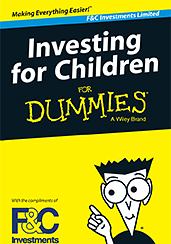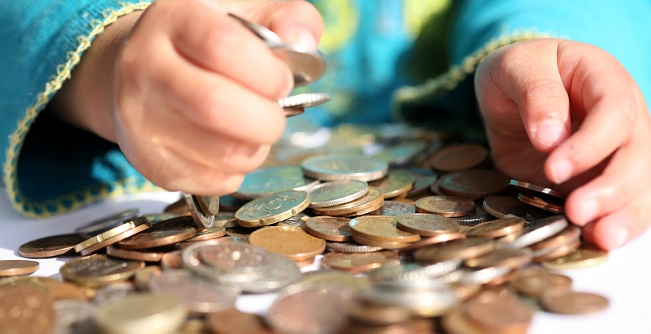Teaching your kids to save money may seem like an obvious lesson to learn but not all parents do. An issue often neglected in schools, learning financial skills is an important asset, especially in today’s post-recession world.
According to a report by researchers at the University of Cambridge, commissioned by the Money Advice Service, children’s money habits are formed at the age of 7. Even children as young as 3 have showed signs of understanding financial ideas such as saving and spending. Parents have a tremendous influence on the way in which their kids view money and it’s up to them to teach the benefits of financial responsibility; children can receive satisfaction out of activities such as pocket money or going to the bank because they feel like a ‘grown up’ in the process and will attempt to emulate the actions of their parents.
There is also evidence to show that children develop financial and economic understanding once they develop their own personal experiences. Therefore, if you give your kids this opportunity to learn the benefits of saving money, their grasp on it will improve greatly. However, do remember that as they grow older their understanding of it will improve, meaning you’ll have to change the ways in which you teach them.
If parents start early and learn how to invest for their children’s future, the lesson of responsibility is being taught every day.
Choosing an account
 There are a multitude of accounts to choose from when it comes to investing in your children’s future and choosing the right one can be difficult. Here are a selection of choices depending on a wide variety of factors that’ll help you make the best choice possible thanks to F&C Investment’s terrific ‘Investing for Children For Dummies’ Guide, which you can download for free right here.
There are a multitude of accounts to choose from when it comes to investing in your children’s future and choosing the right one can be difficult. Here are a selection of choices depending on a wide variety of factors that’ll help you make the best choice possible thanks to F&C Investment’s terrific ‘Investing for Children For Dummies’ Guide, which you can download for free right here.
If you maintain an Individual Savings Account (ISA), you are already aware of the tax-efficient savings. If not, an ISA basically offers you the chance to ease your tax burdens, legally, to the established limits. A Junior ISA is the same concept, only aimed at younger people.
The program was started in 2011 by the government to replace the Child Trust program ensuring that your savings are as tax efficient as possible. It must noted, that this is only available for those born after 2 January 2011 and born before 1 September 2002 if they are not yet eighteen. It is only available to the child once they have turned 18, and from that date onwards it becomes a standard ISA account.
There are also minimums and maximums in terms how much you can invest. For the 2014-2015 tax year, the maximum is £3,840 yet this was due to change from 1 July 2014 to £4,000. Whilst there is no specific amount for minimums, small contributions can still go a long way.
Your role
There are two primary types to this program, which include either a cash earns interest account, which are tax-free or a stocks and shares invests account, which invests the funds in a tax-efficient manner. You can open or add money to both accounts but the total contribution cannot surpass the annual limit.
The Child Trust Fund (CTC) program is also an important choice, which despite not being applicable to children born today, may be useful to know in terms of maximising its benefits later. Aimed at children born between 1 September 2002 and 2 January 2011, similar to an ISA in that no money could be withdrawn until the child is 18. The main difference with the former is that the first contribution was from the government in the form of a CTF voucher.
There are also limits to how much you can contribute, but who the contributions come from doesn’t matter. The annual contribution limit has been raised so it’s aligned with the Junior ISA, which allows a more tax efficient saving for the child. The minimum monthly contribution can be as low as £10, yet the annual maximum is the same as the Junior ISA.
There are three different types of accounts: shares, stakeholder, and savings or cash. While you can no longer set up account, you are still permitted to make changes to an existing fund. The reason for doing so is that over time, you may prefer one time of investment over another, meaning you can still change even after setting up your original account.
Saving and cash accounts are accounts that grow through interest. It must have some exposure to equities but the investment choices are limited and become more and more low-risk as the child gets older. A shares account brings a much wider array of investments and any income generated from an investment will be directly re-invested into the account, as the money cannot be withdrawn until the child is of age.
A personal choice
While these two options are great for parents who wish for their children to access the money once they are 18, this may not be the plan for all parents. There are more flexible options such as Investment Plans Designed For Children, which allows parents to choose when their children may access the money. Personal factors could also dictate your choice instead of government regulations. Sometimes it’s beneficial having an account in which you can access it before your child turns 18, for such instances as school fees, which is not possible with either of the former options.
With this alternative plan, even if it’s under your name, you may be able to add a designation to help you keep better track, which will also make it easier to transfer the money to your child once they have reached the legal age. Conversely, you can also give beneficial ownership to your child, which means it is not part of your estate and escapes inheritance taxes.
Beneficial ownership also comes with plenty of benefits. Inheritance tax can be removed, as your investments are ‘potentially exempt transfers’, so long as you’re around for seven years after the investment. Gains will be free of tax if the chargeable capital gains don’t exceed the child capital gain’s allowance. However, if the money paid in is by the parent, and the income received is more than £100 in a year, the total income for that year is taxed as the parents.
Whist there are plenty of options to choose from, there is no true objectively superior one, as it always comes down to a personal decision. Economic and financial circumstances always affect these kind of choices and what’s beneficial for you now, may not be later. However, most important is remembering that this is a fund for your children and what it all boils down to is whether what you’re doing is going to benefit them in the long run and help them manage their own money in later life.
Breaking through the financial jargon can be a real challenge and many parents struggle to admit they don’t really understand all the ins and outs of financial investment, but with their children’s views on saving money and the future to think about, having a flick through a simple guide like the one created by F&C can make all the difference.








